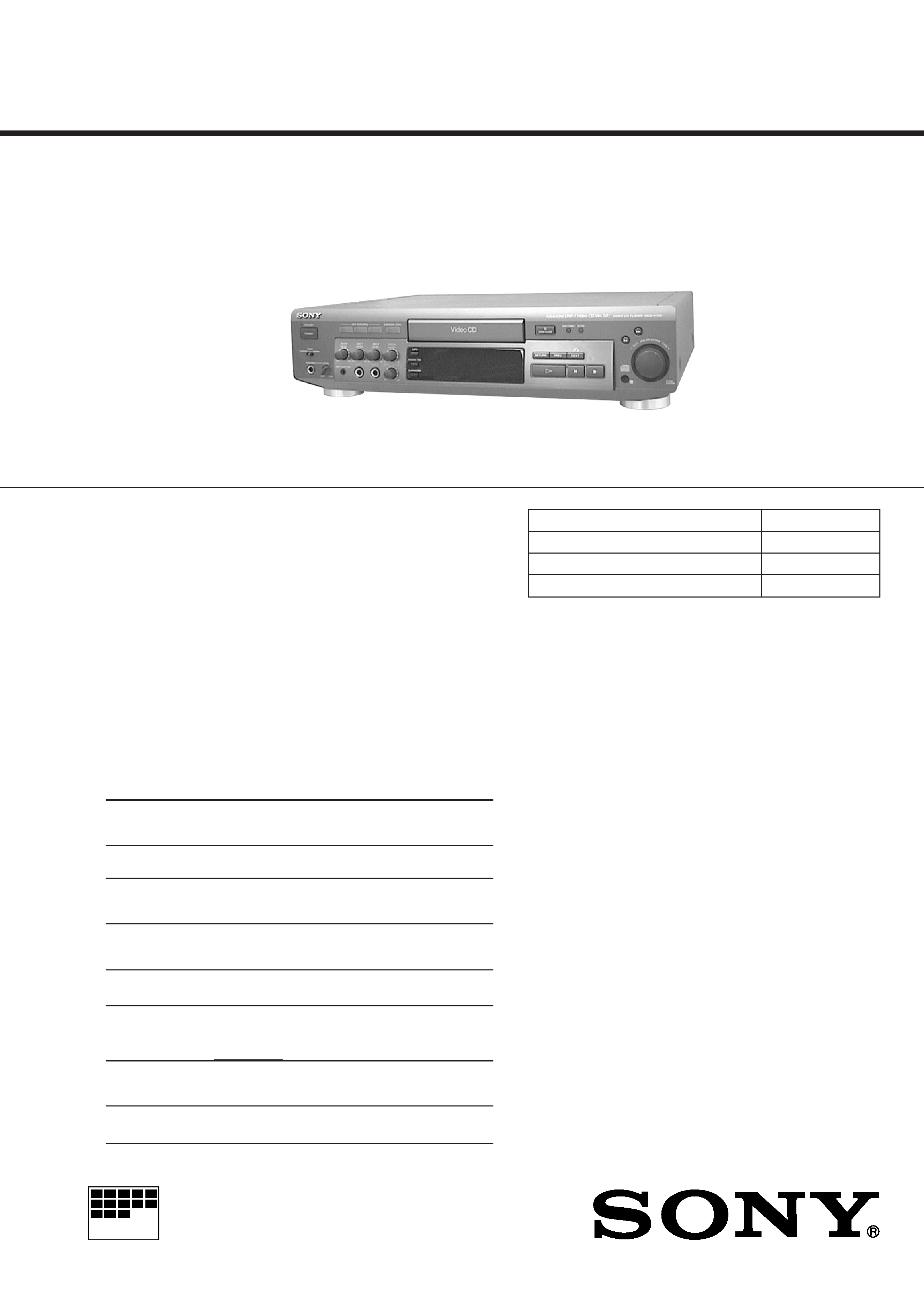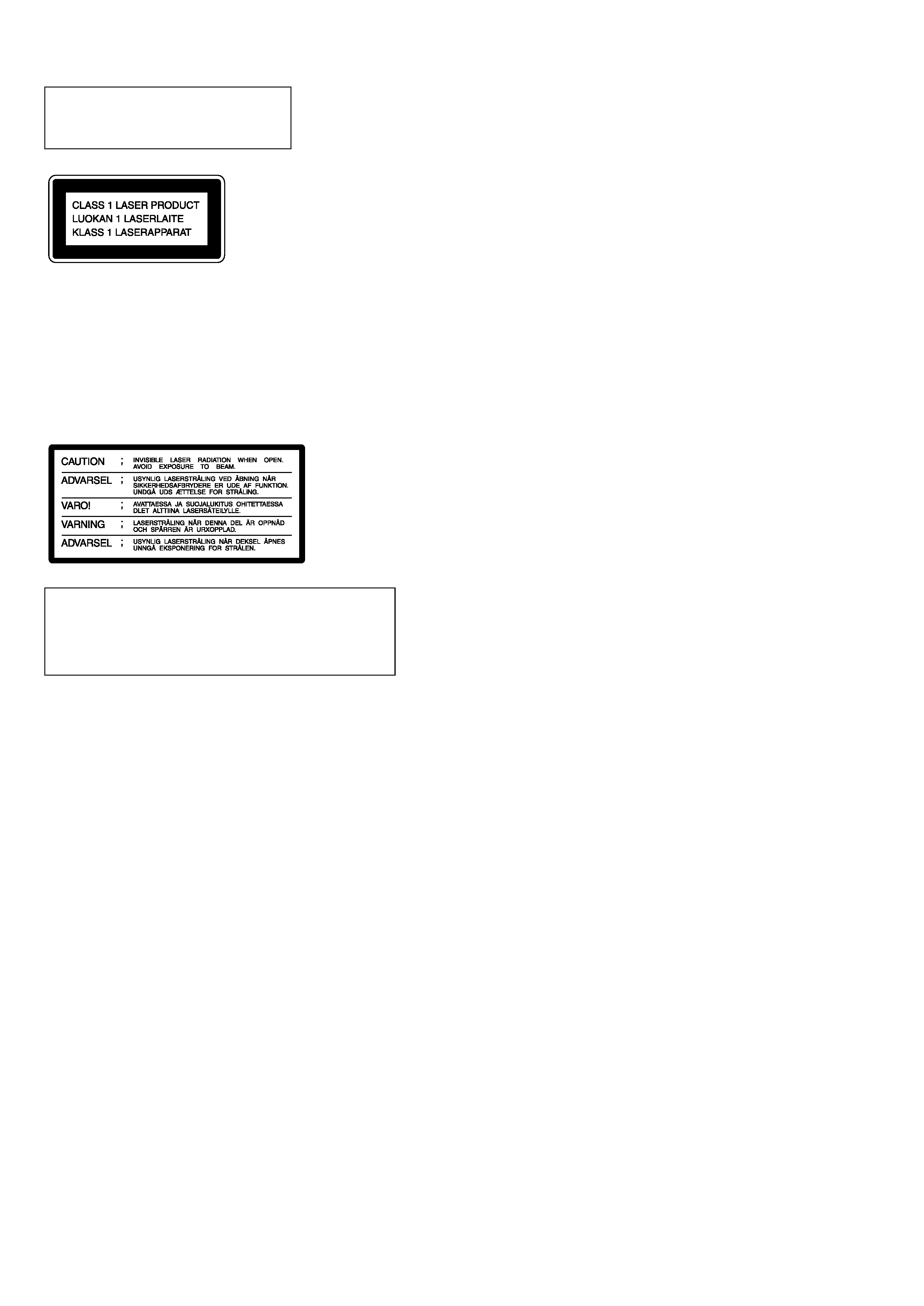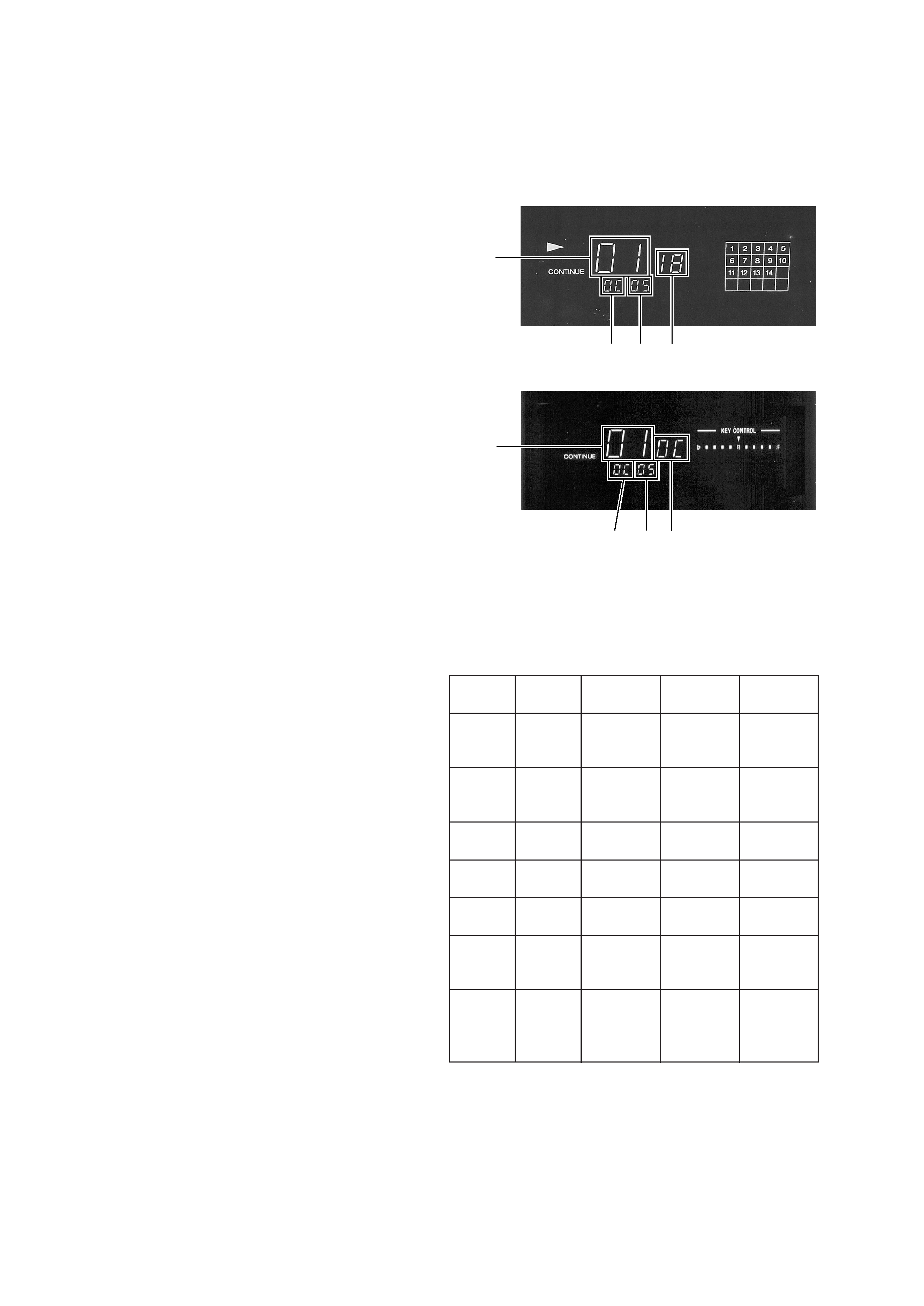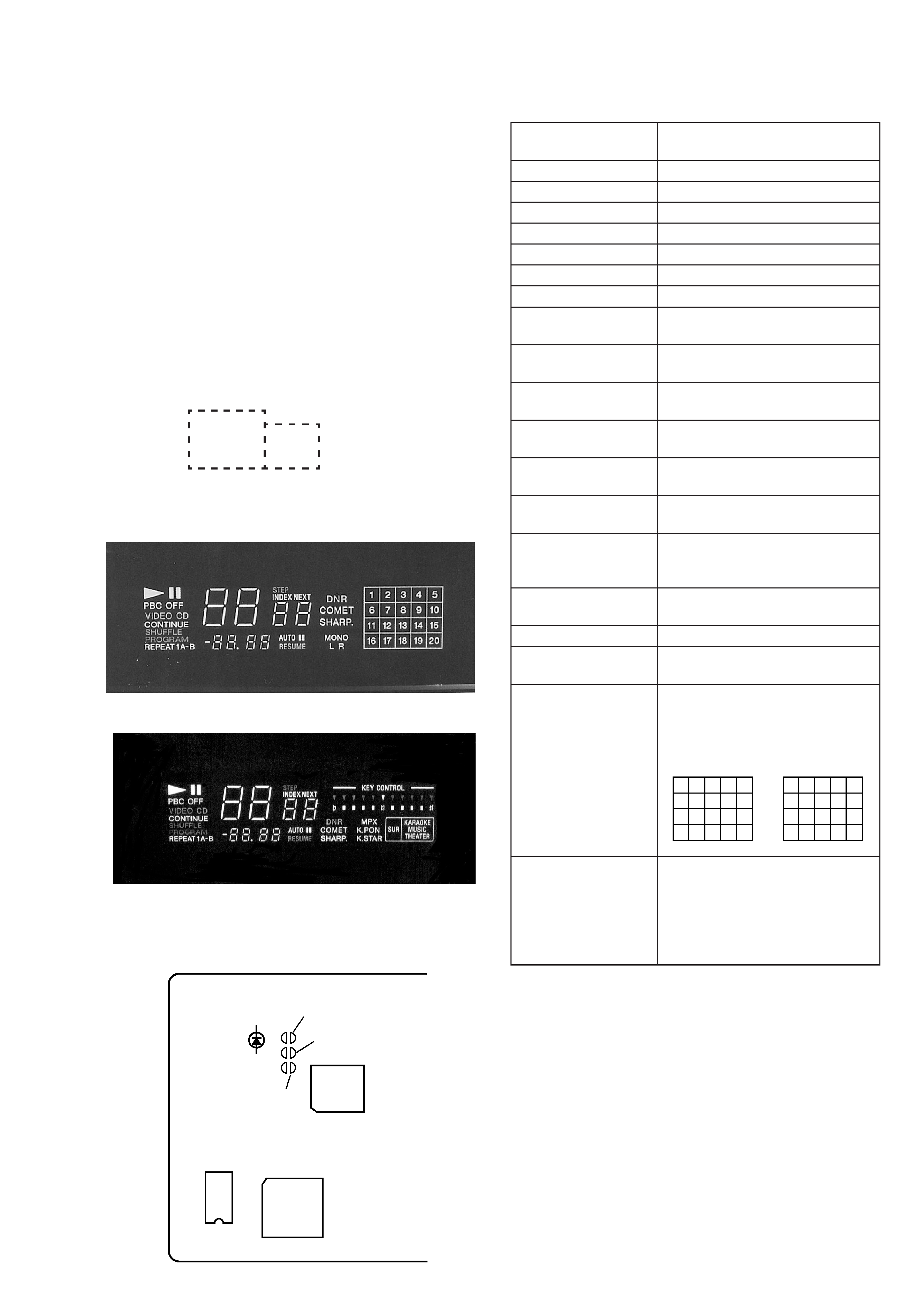
MCE-K550/K750
E Model
Chinese Model
SERVICE MANUAL
VIDEO CD PLAYER
MICROFILM
Model Name Using Similar Mechanism
MCE-S70
CD Mechanism Type
CDM14-5BD24
Base Unit Type
BU-5BD24
Optical Pick-up Type
KSS-213B/S-N
SPECIFICATIONS
PHOTO: MCE-K750
VIDEO CD player
Laser
Semiconductor laser
Wavelength
780-790nm
Signal format system
NTSC, PAL
Frequency response
2Hz to 20kHz
±1dB
Signal-to-noise ratio
More than 94dB
General
Power requirements
(model for Chinese)
220-240V AC, 50/60Hz
(model for other countries)
110-120V or 220-240V AC,
adjustable, 50/60Hz
Power consumption
K550:21W, K750:24W
Dimensions (approx.)
430
×108×350mm
(w/h/d)
inchl. projecting parts
Mass (approx.)
4.4kg
Supplied accessories
Audio and video connecting cord (1)
Remote commander (remote) RMT-K750V/K550V (1)
Sony SUM-3 (NS) battery (2)
Plug adaptor (1) (except model for China)
Desing and specifications are subject to change without notice.
Outputs
AUDIO OUT
VIDEO OUT
S VIDEO OUT
(K750)
PHONES
Jack
type
Phono
jack
Phono
jack
4-pin mini
DIN
Phono
jack
Maximum
output
level
2V
(at 50 kilohms)
1Vp-p
Y:1Vp-p
C:0.286Vp-p
10mW
Load impedance
Over 10 kilohms
75 ohms, unbalanced,
sync negative, white
peak
75 ohms, unbalanced,
sync negative
32ohms
Maximum
input
level
100mVp-p
Inputs
MIC 1,
MIC 2
Jack
type
Phone
jacks
Load impedance
600ohms

-- 2 --
TABLE OF CONTENTS
SAFETY-RELATED COMPONENT WARNING!!
COMPONENTS IDENTIFIED BY MARK
! OR DOTTED LINE WITH
MARK
! ON THE SCHEMATIC DIAGRAMS AND IN THE PARTS
LIST ARE CRITICAL TO SAFE OPERATION. REPLACE THESE
COMPONENTS WITH SONY PARTS WHOSE PART NUMBERS
APPEAR AS SHOWN IN THIS MANUAL OR IN SUPPLEMENTS
PUBLISHED BY SONY.
Notes on chip component replacement
· Never reuse a disconnected chip component.
· Notice that the minus side of a tantalum capacitor may be
damaged by heat.
This appliance is classified as
a CLASS 1 LASER product.
The CLASS 1 LASER
PRODUCT MARKING is
located on the rear exterior.
This caution label is located inside
the unit.
The laser component in this product is
capable of emitting radiation exceeding
the limit for Class 1.
CAUTION
Use of controls or adjustments or performance of
procedures other than those specified herein may result in
hazardous radiation exposure.
1.
SERVICING NOTE ················································ 3
2.
TEST MODE ·································································· 4
3.
GENERAL ······································································ 6
4.
DISASSEMBLY
4-1.
CABINET ··········································································· 7
4-2.
BASE UNIT (BU-5BD24) ················································· 7
5.
ELECTRICAL ADJUSTMENTS ····························· 8
6.
DIAGRAMS
6-1.
CIRCUIT BOARDS LOCATION ···································· 10
6-2.
BLOCK DIAGRAM -- BD SECTION -- ······················ 11
6-3.
BLOCK DIAGRAM -- MAIN SECTION -- ················· 13
6-4.
SCHEMATIC DIAGRAM -- BD SECTION -- ············· 16
6-5.
PRINTED WIRING BOARD -- BD SECTION -- ········ 19
6-6.
PRINTED WIRING BOARD
-- VIDEO SECTION -- ················································· 21
6-7.
SCHEMATIC DIAGRAM
-- VIDEO SECTION -- ·················································· 23
6-8.
SCHEMATIC DIAGRAM
-- DIAPLAY SECTION -- ············································· 27
6-9.
PRINTED WIRING BOARD
-- DISPLAY SECTION-- ··············································· 31
6-10. PRINTED WIRING BOARD -- MAIN SECTION-- ··· 33
6-11. SCHEMATIC DIAGRAM -- MAIN SECTION-- ········· 35
6-12. IC BLOCK DIAGRAMS ················································· 38
6-13. IC PIN FUNCTION ························································· 41
7.
EXPLODED VIEWS
7-1.
CASE SECTION ······························································ 45
7-2.
CHASSIS SECTION ························································ 46
7-3.
MECHANISM DECK SECTION (CDM14M-5BD24) ··· 47
7-4.
BASE UNIT SECTION (BU-5BD24) ····························· 48
8.
ELECRICAL PARTS LIST ······································ 49

-- 3 --
SECTION 1
SERVICING NOTE
SELF-DIAGNOSIS
This model has the self-diagnosis function for the video and audio
decoder sections.
Immediately after the power on, the self-diagnosis function searches
each operation of IC's around the mechanism control microcomputer
(IC504).
The LED (D502) on the VIDEO board indicates their results.
[VIDEO BOARD] -- SIDE A --
HOW TO OPEN THE DISC TRAY WHEN POWER SWITCH
TURNS OFF
Insert a screwdriver into the aperture of the unit bottom, and turn in
the direction of arrow (to OUT direction).
* To close the disc table, turn the screwdriver in the reverse direction
(to IN direction).
NOTES ON HANDLING THE OPTICAL PICK-UP BLOCK
OR BASE UNIT
The laser diode in the optical pick-up block may suffer electrostatic
break-down because of the potential difference generated by the
charged electrostatic load, etc. on clothing and the human body.
During repair, pay attention to electrostatic break-down and also
use the procedure in the printed matter which is included in the
repair parts.
The flexible board is easily damaged and should be handled with
care.
NOTES ON LASER DIODE EMISSION CHECK
The laser beam on this model is concentrated so as to be focused on
the disc reflective surface by the objective lens in the optical pick-
up block. Therefore, when checking the laser diode emission,
observe from more than 30 cm away from the objective lens.
LASER DIODE AND FOCUS SEARCH OPERATION
CHECK
Carry out the "S curve check" in "CD section adjustment" and check
that the S curve waveform is output three times.
LED (D101) INDICATION
Light
1 Time blinking (Repeatedly)
2 Time blinking (Repeatedly)
SYMPTOM
No error
Video decoder error
(IC503)
Video RAM error (IC502)
Screwdriver
IN
OUT
Pull out disc table.
IC503
IC502
IC504
D502
SL501
SL503
SL502

-- 4 --
SECTION 2
TEST MODE
VIDEO CD COLOR-BARS MODE
On this mode, the data of the color-bars signal as a picture signal
and the 1kHz sine wave signal as a sound signal are output by the
mechanism control microcomputer (IC504) for video CD signal
check. When measurement of the voltage and waveform on the
MAIN board, perform it in this mode.
For reference, the color-bars signal can be observed at J103 (VIDEO
OUT) and the sound signal can be observed at J104 (AUDIO OUT)
using an oscilloscope.
1.
Connect the SL503 (C BAR (MICON)) on the VIDEO board
with solder.
2.
Turn the power on.
3.
After measuring, remove the soldering installed.
SERVO CHECK MODE
1.
Connect the SL502 on the VIDEO board with solder.
2.
Turn the power on.
1)
Coefficient display and gain display
The following hexadecimal data is displayed on the FL tube
when the JOG SELECTOR key is pressed. Every pressing of
the JOG SELECTOR key toggles between the following
displays.
2)
Pressing of the DNR/COMET key toggles between ON and
OFF of the tracking and sled servo.
3)
Pressing the PLAY MODE key (KARAOKE PON in K750)
during playback increases the FB value (every 4 steps).
Pressing the REPEAT key (SURROUND in K750) decreases
the FB value (every 4 steps).
4)
Pressing the ACTIVE key toggles between the normal speed
and double speed.
5)
Pressing the RETURN key toggles between the up FIL and
NO FIL.
6)
Pressing A
B key performs re-measurement of focus bias.
Display
position
Display
mode 1
Display
mode 2
Display
mode 3
Display
mode 4
Display
mode 5
Display
mode 6
Display
mode 7
TRACK
01
02
03
04
05
06
07
INDEX
FB POINT
(when jitter
is minimum)
00
TRVSC
RESISTER
VC
OFFSET
FCS AUTO
GAIN
RF PEAK
RF
BOTTOM
Set the
present FB
REGISTER
value
MIN
AUTO FB
POINT
FB upper
limit
00
FE
OFFSET
00
RF PEAK
00
SEC
RF JITTER
MINIMUM
VALUE
FB lower
limit
TE
RESISTER
RF
OFFSET
TRK AUTO
GAIN
RF
BOTTOM
Present RF
JITTER
value
TRACK
MIN SEC INDEX
Initial display (K550)
TRACK
MIN SEC INDEX
Initial display (K750)

-- 5 --
Lighting of All Fluorescent Indicator Tube
Displays and Key Check Mode
1.
Connect SL501 on the VIDEO board with solder.
2.
Turn the power on.
3.
All the Fluorescent Indicator tube displays light up.
4.
Press any button to enter the key check mode. In the key check
mode, each time a button is pressed, figures displayed on the
Fluorescent Indicator tube displays increase. However, figures
will not increase for buttons which have been pressed once.
The button number corresponding to the button pressed will
also be displayed. Button numbers are displayed only while
the corresponding buttons are pressed.
5.
After the test mode, remove the soldering installed.
7-segment display
Initial display (K550)
Initial display (K750)
[ VIDEO BOARD ] -- SIDE A --
8888
n
Count up display
Button number display
n
Button Name
NEXT
^
§OPEN/CLOSE
RETURN
PREV
º
,
DNR
MPX (K750)
L/R/STEREO (K550)
SURROUND (K750)
REPEAT (K550)
KEY CONTROL
N
(K750)
KARAOKE STAR
(K750)
KEY CONTROL #
(K750)
KEY CONTROL
~
(K750)
KARAOKE PON
(K750)
PLAY MODE (K550)
JOG SELECTOR
(PUSH SELECT)
ACTIVE/COMET
p
·
Button Number (Displayed only
while a button is pressed.)
Figure 0E
Figure 16
Figure 30
Figure 31
Figure 33
Figure 34
Figure 48
Figure 50
Figure 5d
Figure 67
Figure 68
Figure 6b
Figure 6c
Figure 77
Figure 81
Figure 88
All Fluorescent Indicator tube
displays light up
Music calendar light up alternately
(K550)
(odd numbor to even number)
KEY indicater light up alternately
(K750)
7-segments displays light up
alternately
The odd number digits and the even
number digit of the upper 7-segments
displays and the lower 7-segments
displays light up alternately.
13
79
5
11
13
17
19
15
68
24
10
16
18
12
14
20
IC503
IC502
IC504
D502
SL501
SL503
SL502
